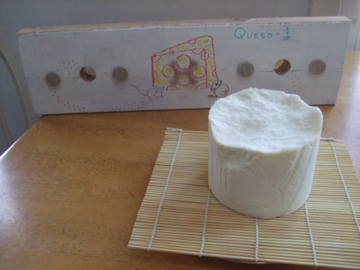
Farmhouse Cheddar
This weekend, we continued our cheese-making tradition by creating our first hard cheese: a farmhouse cheddar. Hard cheese requires more time and care than soft. And, although some soft cheeses are pressed (to remove water) and aged (to develop flavor), typically the pressing and aging times are much shorter.
Farmhouse cheddar is basically a white cheese that utilizes a mesophilic starter culture to develop flavor over time. Its ingredients are almost precisely the same as a more complex, standard cheddar: two gallons of milk, a starter culture, rennet and salt. Instead, variables have to do with (a) the time and temperature applied to separate the curds from the whey, (b) pressure and pressing time applied through the pressing process and (c) aging time, including a temperature component (no mention is made of humidity).
The difference, according to the book, is that farmhouse cheddar is white and crumbly, whereas a traditional cheddar cuts more keenly and develops a sharper flavor (depending, in part, upon aging).
In the interest of learning more about how cheese is made (and sharing those questions with you), I’ll share a little about the major components in the process.
What does rennet do?
Rennet, an enzyme, basically separates the major components of milk (casein, water) apart by coagulating the casein (fat, protein, minerals) and leaving the whey (water and some sugar) as a remainder. Our cheese was made with vegetable rennet, tablets made from plant enzymes rather than mammalian enzymes.
What roles does the starter culture play?
The mesophilic (mildly-warm temperature-loving bacteria) starter culture (Lactococcus lactis subsp. lactis and Lactococcus lactis subsp. cremoris) eat lactose, and release lactic acid and Co2 (among other changes and transformations they promote). As the curds are seperated from the whey, the starter bacteria begin their work. But their work really happens over the course of aging which, in our case, is only several weeks – fast!
How does time impact flavor?
Our friendly Lactococcus bacteria love a certain kind of environment; pH and so on. Their conversion of lactose into lactic acid proceeds until their environment is no longer suitable. Presumably, as they change evermore lactose into lactic acid (and release or impact other chemical balances), the flavors of the cheese evolve.
How was the press built?
The press is really quite simple, and the general concept is illustrated online. Our press, Queso-1, uses this generic pressing process and weights kindly donated through a Cambridge, MA Freecycler. We’re using a food-grade cheese mold and follower, and a stainless steel drip pan.
To dry the cheese, we’ve rested it on a sushi roll mat (great, because it has little slats to allow for air movement) and are storing it under a colander, under a plate (to keep the dust off, and air flowing).
Edit: three months on, what does it taste like?
Pretty good! A little dry and flakey, and somewhat sharp.
Recent Comments